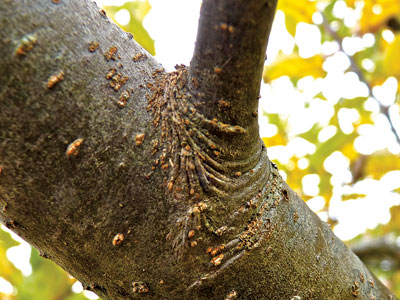 |
| The branch collar is the wrinkled-looking tissue where one branch joins another or joins the trunk of a tree. English photo. |
By C.J. Walke
As the ground freezes and winter takes hold, our fruit trees become dormant and settle in for their own winter’s nap. The trees may be dormant and we may spend more time indoors, but some pests are still active – specifically deer and meadow voles, emphasizing the importance of winter preparations. (See The MOF&G, Sept.-Nov. 2010.) Early December is not too late to put vole guards on trees, if you haven’t already, but they should be on before the first lasting snowfall to protect tender trunk tissue from hungry voles and even rabbits or hares. During winter, skiing or snowshoeing through the orchard can compact vole tunnels, making the snow and ice too tough for voles to penetrate. Winter is also the time to browse through catalogs, order supplies and plan for the next season.
Pruning Fruit Trees
The primary goals of pruning are to maintain the structure of the tree and to open the canopy to allow sunlight to reach all leaves and fruit, while also allowing air to circulate and dry out moisture, which lessens the chance that fungal diseases, such as scab, will set in. Tree structure can be maintained by establishing solid scaffolding branches, anticipating the growth of future branches and controlling the tree’s height. Good light penetration throughout the tree will enhance photosynthesis, increase fruit cell development and improve fruit color.
Fruit trees are best pruned during the dormant season – typically late February and into March in the Northeast. People sometimes say that pruning is best done “when the knife is sharp,” but as with most agricultural endeavors, there is the ideal time and there’s the time you have available. The ideal time to prune fruit trees is while the tree is dormant and when temperatures are no longer likely to dip below zero at night. A tree will have a harder time healing a pruning cut that is exposed to subzero temperatures, because the cold can slow or interrupt the healing process, making the wound susceptible to winter injury and creating the perfect place for harmful fungi, such as black rot, to colonize and take hold once spring arrives.
Two basic types of pruning cuts, the thinning cut and heading cut, are used in different situations and cause the tree to respond in different ways. A thinning cut is used to remove an entire branch, ranging from a larger branch that is removed to make space for newer growth to a 1-year-old shoot growing in an unwanted direction. Thinning cuts are made at branch unions, and the proper cut needs to be just flush with the branch collar. The branch collar – the somewhat wrinkled looking bark tissue at the branch union – contains protective tissue that will heal the wound and create a callus ring. Cutting into the branch collar will disrupt the healing process and leave the vascular system open to infection, so take care with the cut.
Heading cuts are made along a branch, away from the branch union and collar, and encourage the growth of buds and shoots down the limb from the cut. A heading cut made on 1-year-old wood will initiate strong vertical growth from the three or four buds below the cut, because once the terminal bud of that shoot has been removed, those three or four buds try to replace it as the leader of the shoot. Heading cuts are commonly made on a young whip in order to establish the first scaffolding branches of the young tree, where one of the buds will become the leader and the others can be trained as the first scaffolds. A heading cut made on 2-year-old wood will encourage the growth of spurs and shoots along the branch without initiating strong vertical growth, although one bud will take over as the leader. Heading cuts on older wood tend to further invigorate spur and shoot growth on the branch, but can also be more difficult for the tree to heal and effectively callus over, which can lead to infection.
Pruning is easier done than said (or written), but all it really takes are the right tools, a mind for the basics and a vision for how you want the tree to look in a few years. Make sure your tools are sharp and your cuts are clean, and the tree will take care of the rest. Also, MOFGA offers a pruning workshop at three Maine locations in March, which is the place to get hands-on experience; see www.mofga.org for dates and details.
C.J. Walke is MOFGA’s landscape coordinator, organic orchardist and librarian. Readers may contact Walke at (207) 568-4142, [email protected], or talk with him at one of MOFGA’s educational events.
